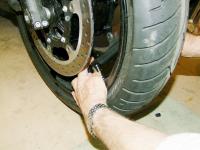I have OE type short straight valve stems. I rarely put the FJR on the centerstand so I typically measure pressures while on the sidestand.
How do you position the FJR to check pressures?
Do you always check rear pressure while on centerstand?
Where do you like to have wheel/valve stems positioned for easiest checking? If you have angled stems is wheel positioning important for you?
Quickest, most efficient way to get front wheel in the desired gauging position?
How do you position the FJR to check pressures?
Do you always check rear pressure while on centerstand?
Where do you like to have wheel/valve stems positioned for easiest checking? If you have angled stems is wheel positioning important for you?
Quickest, most efficient way to get front wheel in the desired gauging position?




